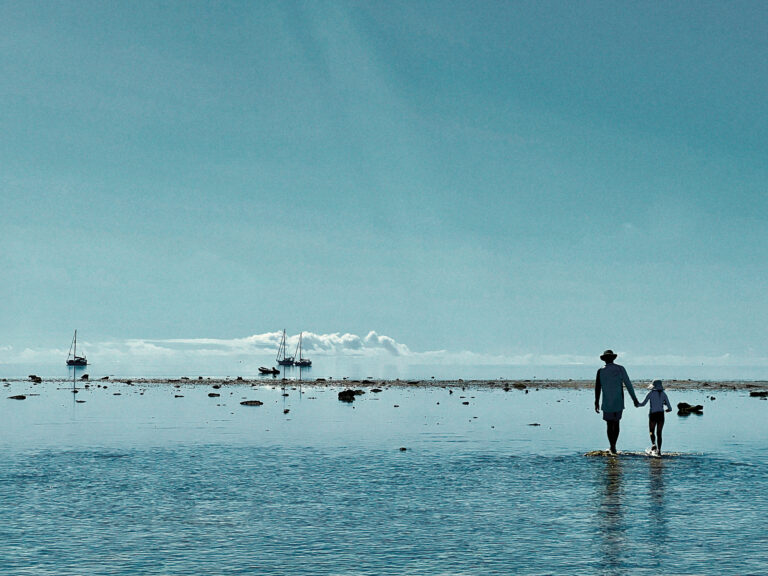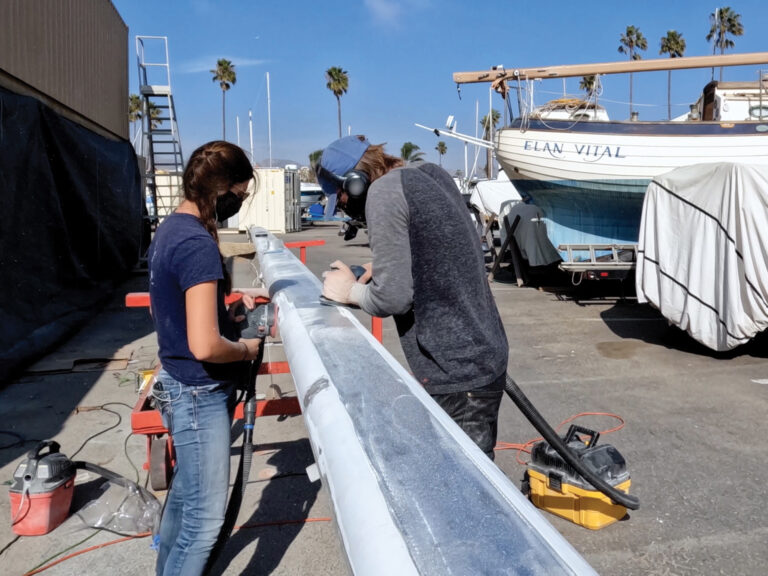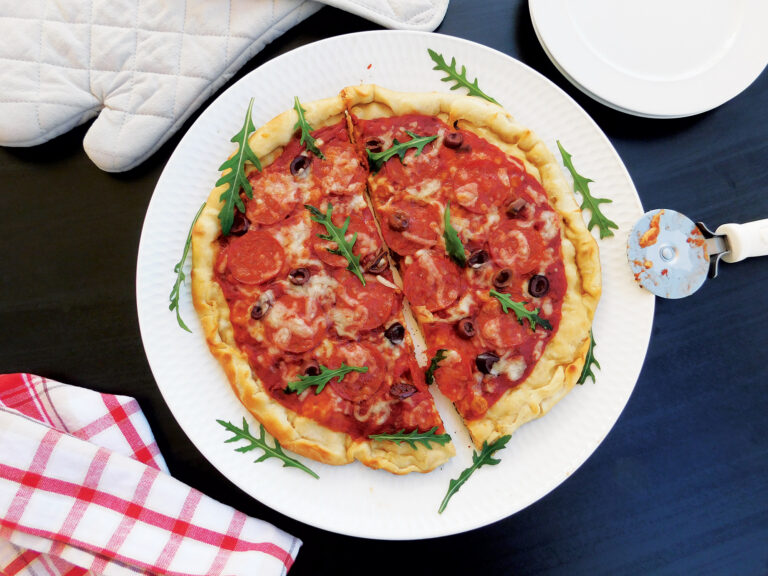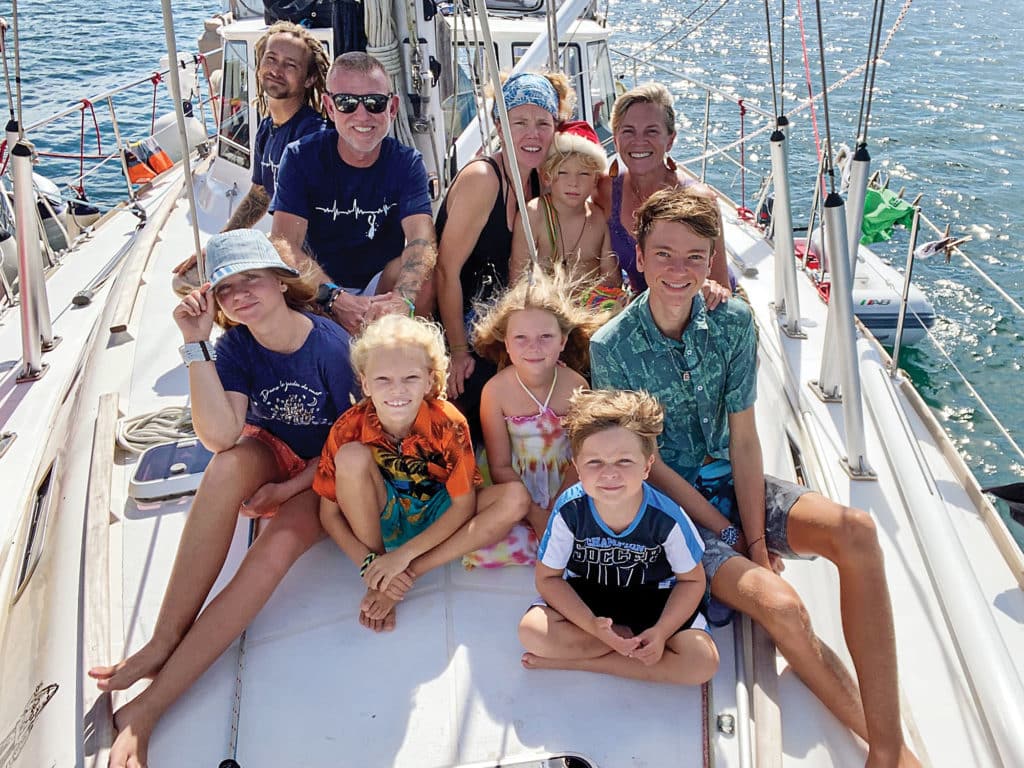
Have you got your pants on?” Charlie shouts through a side hatch and into the galley of the 49-foot Westerly Selkie.
Nick wanders over to collect the delicious, crispy French baguettes that Charlie has brought over from Lucky Girl, which is anchored alongside.
“Thanks, Capt. Charlie. I’ll make sure to put some pants on and come on over for some of that fresh-ground coffee,” Nick tells him.
The four children aboard Selkie tear apart the bread. Crumbs fall everywhere, and tummies fill comfortably as the boats gently sway at anchor in the Caribbean waters of Antigua.
“Buddy boats are truly the best when food delivery is included,” Nick whispers.
Fifteen months later, we all still wake to baguette deliveries from one boat to the other, and the endlessly repeating question about whether people are wearing pants on either boat at any given time. Like a catamaran that has been split in two, our monohulls have crossed oceans as a team. We have made it from the Atlantic to the Pacific as buddy boats.
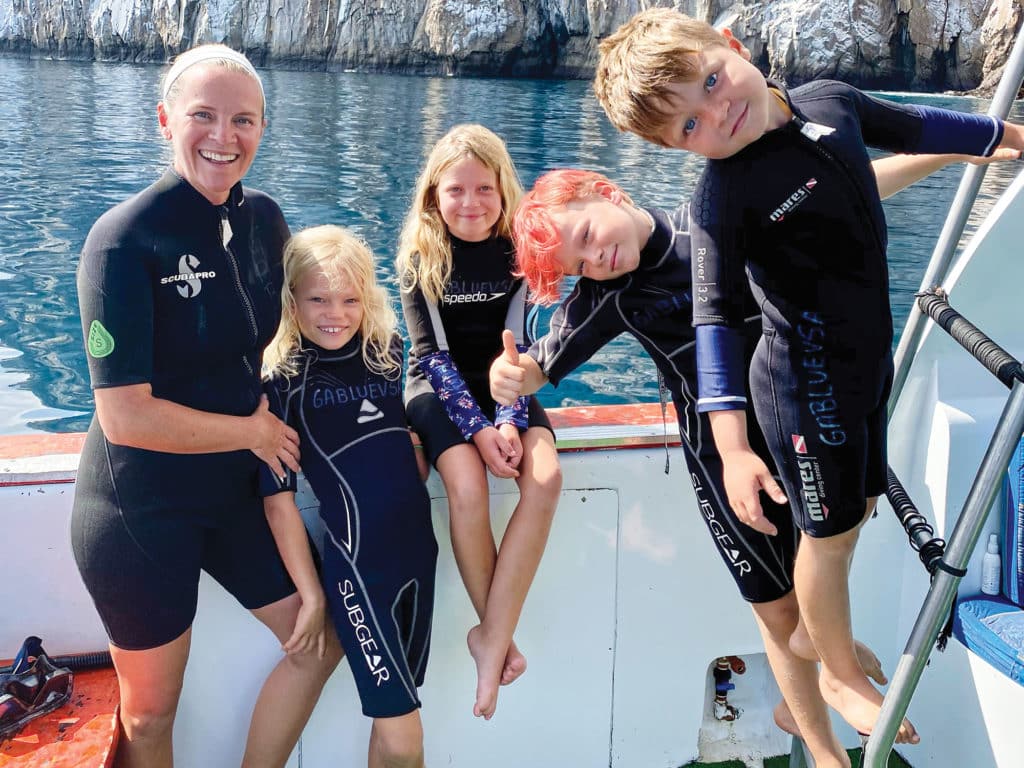
How we do it
Cruising is about seeing spectacular new places, experiencing different cultures, and meeting interesting people—but it’s not a holiday. It’s a lifestyle. You could sustain a few weeks, maybe even a few months, with just your own crew and transient friends, but it doesn’t take long before you miss real, long-term human connections. You yearn for people you don’t have to try to impress, people you can invite to a dinner of leftovers and half a bottle of wine.
We became those things to each other starting in Barbuda on a pristine, crystal-clear day. Kids were on paddleboards, being dragged by a dinghy, spilling laughter into the waves. Maggie was rowing around the anchorage to meet the adults—cocktails in hand—when she spotted the Scottish flag on Helen’s boat. Maggie shouted to the man aboard, “You’re from Scotland?”
“Yes,” he replied.
“We’re going to be friends!” she answered.
Helen’s liveaboard family had just finished a year in Scotland.
“Are you Nick’s wife from Selkie?”
“Yes.”
“You’re right,” he replied. “We are going to be friends.”
And just like that, our buddy-boat relationship was forged. Later that night, we strengthened our bond with a beach bonfire, marshmallows and reminiscences of Scotland. As it turns out, our husbands mesh well, and our kids mix like a delicious smoothie. We, the wives, are the blender. Our plans, our boats, our education, our cooking, our support of each other—we keep these buddy boats moving with the kind of support that fills the sails like the wind you can’t see.
Like a catamaran that has been split in two, our monohulls have crossed oceans as a team.
When we have a moment not corralling the kids for school or an adventure, we have conversation. Our husbands play us a song on a guitar or look to the logistics of the next crossing. We hug, because life is not easy, and when that happens, we are recharged. We are two families who know life as survival and exploration, and who take comfort in having company amid the darkness and mystery of the ocean.
For instance, there was the time when Lucky Girl lost sight of Selkie on Day Two of our Pacific crossing. A call on the SSB, on Day Nine, brought us back together in spirit until, a half-hour later, we could see each other’s lights on the horizon. The Milky Way trailed through the night sky as we reconnected, enchanted to be back together.
Seeing a friendly light on the horizon on a night watch on a long passage is not just reassuring—it can be lifesaving in an emergency. Two boats sailing together also have the advantage of double the spare parts and tools (and provisions—someone always needs an egg for baking). We have double the thinking power for troubleshooting practical problems, and double the people power for doing a job. One of our husbands is an engineer, so he helps with mechanical and technical problems. The other runs his own business, so he’s great on the management of personal relations from country to country. The husbands are always crawling in and out of each other’s engine rooms and anchor lockers. The wives are swapping books for education and ideas for adventures.
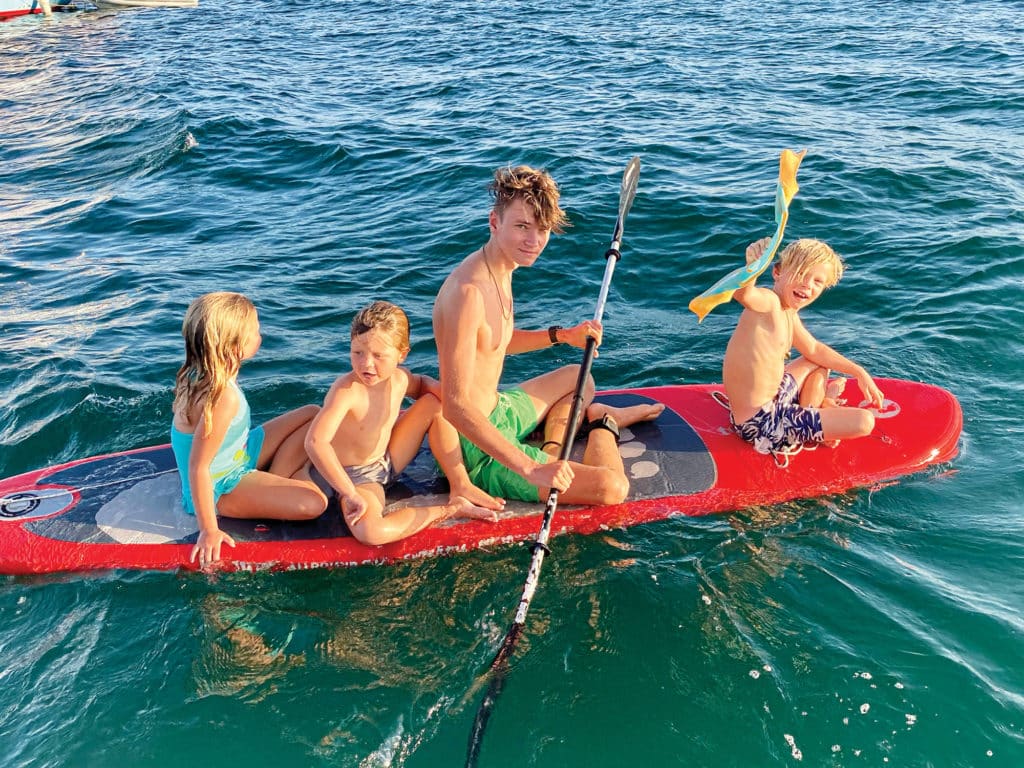
Of course, two boats also means double the waiting time for spare parts or jobs to be finished, or adjusting schedules to fit with obligations such as visitors, work commitments or online education.
And illness can present challenges. When Lucky Girl’s incoming crew got COVID-19, both boats had to wait to keep cruising. Then, the virus hit Selkie too. Both boats waited again. Finally, when everyone was feeling better, we did plenty of provisioning to make up for time lost.
We’ve also needed to make compromises to suit our different family rules, such as screen-time allowances, but we also can work together to motivate our children. With different school schedules and holidays (Selkie is American; Lucky Girl is British), we’ve found adjustments that are beneficial for all, such as adding in “sail camp” as a summer course, more field trips, or study of a local language that doesn’t contain the normal demands of a typical school day at sea. These small changes are easily worth the effort.
And, we’ve had other buddy boats in addition to each other. Lucky Girl sailed as a group of four in 2021, and it worked well for a few months. Selkie stayed with five boats, before and after crossing the Atlantic Ocean from 2020 into 2021, and it was loads of fun.
But while big groups can be exciting, planning becomes complicated. With big groups, our recommendation is to sail with generalities—meaning roundabout whereabouts and casual encounters.
It’s also important to remember the little things. Buddy boating can be filled with shared coffee grinds and espresso presents, kid tea parties on a double-rafted bow, matching T-shirts from matching outings, double paddleboards for double the children, double the participants for board-game competitions, extra scuba crew for lost items on the bottom of the sea, more presents for holidays and birthdays, more singing voices for celebrations or howling at the moon, double the comfort when a day goes wrong, more memories to share and enjoy, extra hiking crew to divide and conquer, double the crew to admire sea lions and tortoises, double the snorkelers to notice a shark, double the teams for a scavenger hunt, double the crew for crafts and pizza, more eyes and thoughts for sloth searches and museum visits, double the contemplation on land excursions, more fake laughs for bad jokes, double the toys, more hands for bonfire-making, double the finger turns for complicated puzzles, lots more toes for sand digging, double the friends for dancing, and an extra person to keep you smiling.
Buddy-boat tips and advice
Our tips for good buddy-boat relations are pretty simple. For starters, we recommend looking for an instant connection. For us, it was a shared love of Scotland. We got along from the very start.
You also need similar captains. Ours happen to be hardworking, exercising-loving, project-fixing adventurers. And, of course, it helps if you and your own friend are similar. As wives, we share the utmost kindness and empathy, cookery and mischief, mothering and teaching, and constant love of exploration. We also have kids in similar situations: Selkie has two teens and two kids younger than 10, while Lucky Girl has two more younger than 10. The teens help, and the younger kids rush to get their schoolwork done to see one another.
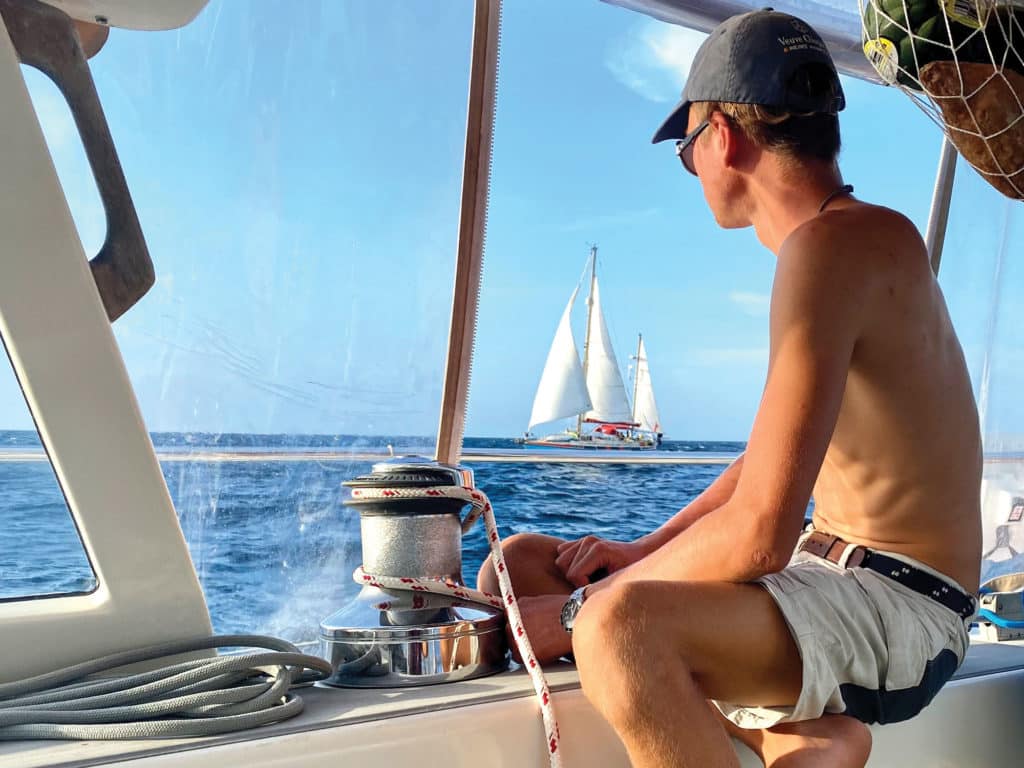
Similar itineraries are also a must. We met in the Caribbean after both crossing the Atlantic Ocean and having already made plans for hurricane season. Selkie went to the Dominican Republic and Guatemala, and Lucky Girl went to the ABC islands. We agreed to meet up again in Panama, crossed the canal tied together, and then crossed the Pacific together. We are currently exploring the Pacific islands and planning on time off in New Zealand together. None of us have fixed ideas about where to go, and we all know that it is more important that we go together. Routes and itineraries can be adjusted.
We also enjoy the same types of side activities. We like renting cars and zooming to archaeological sites. We enjoy scuba, snorkeling and free-
diving together. Though our husbands agree about their hatred of beaches, we and the children play in the waves and build in the sand. We grocery shop together and have chili cook-offs. We find fun local excursions that include pools or hikes. Recently, we both bought small, inflatable catamarans called MiniCats, by Guppy, to race in bays for fun.
We are all willing to make changes. When one boat has visitors on board, has a date set to take a break onshore at a rental apartment, or is dealing with illness or injury, the other boat slows down or speeds up. If a mechanism breaks, the other boat helps or waits for the parts to be delivered. We get and give mutual support, because as sailing families, we know what the other is going through. Honesty helps as well.
Whenever possible, we raft up. Hands down, rafting is the best way to float in a bay (even if you damage a solar panel or bash a bit with swell). And we have similar budget allowances for repairs, land activities and eating out. We prefer to keep accounts and give allowances for wee splurges here and there.
Relationships don’t just happen. There’s work involved. Selkie and Lucky Girl know that we do better together, so we work for that, but we also know when it is OK to go our separate ways for a bit and catch up again later. For example, if one boat has visitors on a sightseeing schedule, they move faster. If Selkie’s set of teens is keen to keep up with other teen-boat kids, we separate for a bit.
We often hear families aboard other boats lamenting the lack of other kids to sail with, and we wonder why they are sticking so rigidly to their itineraries rather than making the effort to stay with the family boats they do find.
After all, when we’re all done cruising, we’re sure it’s the people we will remember rather than the places. So, despite some potential challenges, if you have the same basic expectations, timelines and budgets, we think buddy boating, like all good long-term relationships, is more than worth the effort.
Two boats really become one. When you feel that click, don’t let go.






